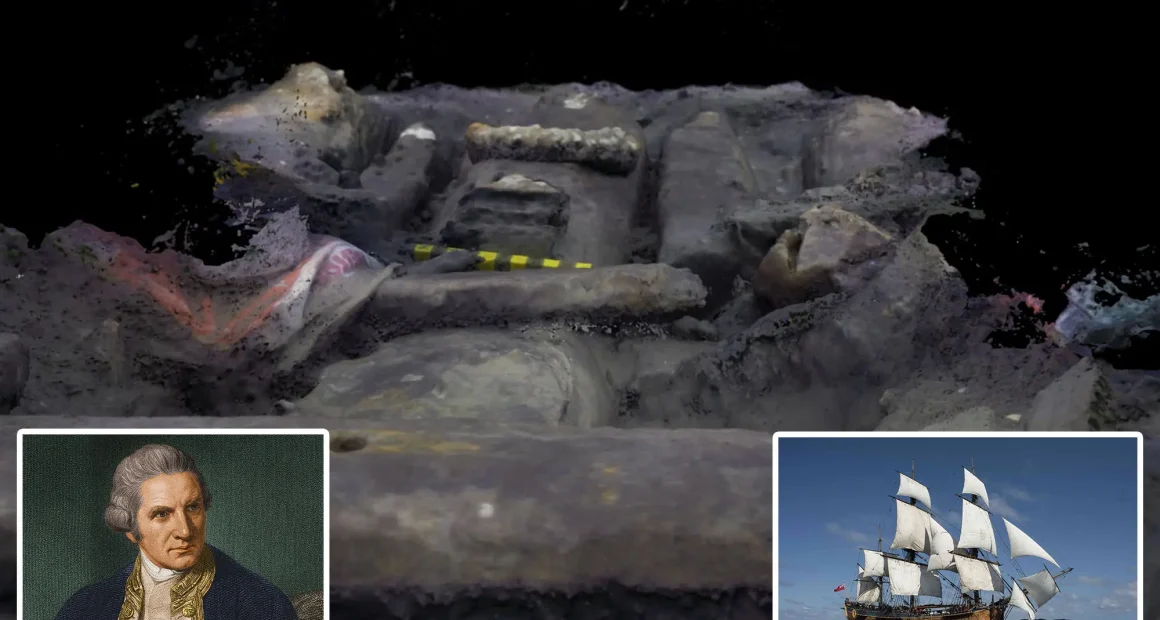Holy Ship.
Captain James Cook’s legendary vessel, the HMS Endeavour, has been rediscovered off the coast of Rhode Island—bringing a dramatic end to a 250-year-old maritime mystery.
The iconic ship’s long-speculated resting place was detailed in a recent report by the Australian National Maritime Museum, which has been on the hunt for the Endeavour since 1999.
A replica of the HMS Endeavour, the legendary ship commanded by Captain James Cook.
“This final report is the culmination of 25 years of detailed and meticulous archaeological study on this important vessel,” said museum director Daryl Karp, describing the document as the project’s “definitive statement,” according to Pen News. “It has involved underwater investigation in the U.S. and extensive research in institutions across the globe.”
The HMS Endeavour, commanded by British explorer Captain James Cook, embarked on its first voyage from 1768 to 1771. During that historic expedition, the ship circumnavigated the globe, became the first European vessel to reach the eastern coast of Australia, and completed the first known circumnavigation of New Zealand.
The legendary vessel soon faded into obscurity. After its groundbreaking voyage, the Endeavour was repurposed as a transport ship for British troops.
In the years that followed, it was sold to the shipping company Mather & Co. and, in 1775, refitted and renamed the Lord Sandwich. Under this new identity, the ship joined the British fleet during the American Revolutionary War.
The Endeavour was ultimately scuttled off the coast of the United States in 1778.
For nearly two and a half centuries, its remains rested undisturbed at the bottom of the sea—until maritime archaeologists formally identified the wreck, known as RI 2394, in Newport Harbor, Rhode Island.
Researchers confirmed the vessel’s identity by meticulously comparing the wreckage to historical ship plans. Key structural features, including the placement of specific timbers, precisely matched the positions of the main and fore masts shown in the original schematics—providing definitive evidence that the long-lost Endeavour had finally been found
Meanwhile, the wreck’s dimensions closely matched those recorded during an original 1768 survey of the Endeavour.
“The size of all the timber scantlings are almost identical to Endeavour—and I’m talking within millimeters, not inches, but millimeters,” said Kieran Hosty, an archaeologist with the Australian National Maritime Museum (ANMM). “The stem scarf is identical, absolutely identical.”
He added, “This stem scarf is also a very unique feature — we’ve gone through a whole bunch of 18th-century ship plans, and we can’t find anything else like it.”
Further supporting the identification, wood analysis revealed that the timber used in the wreck was of British origin—a detail consistent with records showing the Endeavour underwent repairs in 1776.
Despite this compelling body of evidence, the ANMM’s declaration has not been without controversy. After the museum published its preliminary findings in 2022, its American research partners at the Rhode Island Marine Archaeology Project (RIMAP) pushed back. They claimed that the announcement was “premature,” asserting that they were leading the investigation and that the disclosure breached their partnership agreement.
In a subsequent statement, ANMM acknowledged RIMAP’s contributions, praising their “fine historical analysis and detailed artifact recording.” The museum noted that while RIMAP maintains RI 2394 may be the Endeavour, the organization “is not ruling out other candidate shipwreck sites.”
A painting of the legendary English explorer Captain James Cook.
Nonetheless, ANMM archaeologist James Hunter insists there is enough evidence to confirm the ship’s identity. He explained that the Endeavour was “intentionally scuttled,” making the chances of finding easily identifiable artifacts—like a ship’s bell—very slim.
“Anything of value would have been removed before the ship was sunk,” Hunter said. “But what has been recovered so far is consistent with an 18th-century timeframe.”
“You’ll never find a sign saying ‘Cook was here,’” agreed Hosty. “But we have a whole series of evidence pointing to RI 2394 as being… the Endeavour.”
He added, “So far, we’ve found many things that tick the boxes for it to be the Endeavour, and nothing at the site that contradicts that.”








